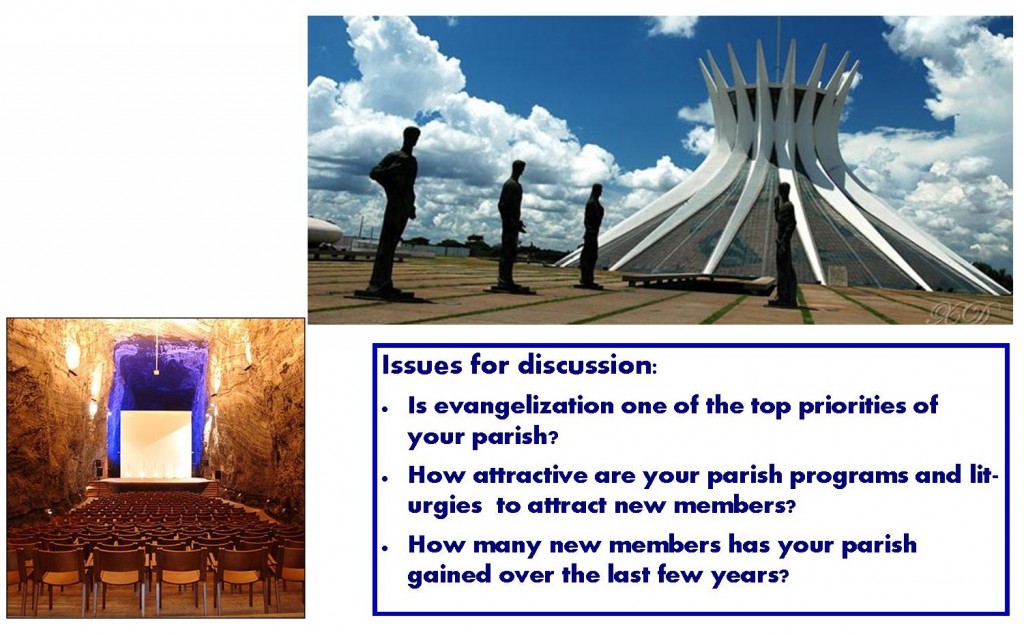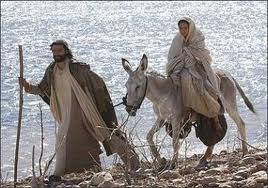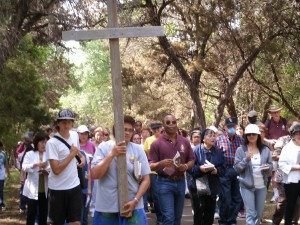3 - PARISH EVANGELIZATION. Images of the Future Church.

|
Dear U.S. friends, We are a missionary church; evangelization is our first priority. Of course we have to evangelize ourselves first, and help others do so; but after a certain level, one has to come out of the cocoon of private or semi-private devotions. I spoke the other day with a fellow from my district; he is not a preacher, but will occasionally do so. I asked him obliquely how often he reads the bible. “Five minutes?” – “Maybe half an hour. Half an hour in the morning; half an hour in the afternoon, half an hour at night. Because sometimes I have to improvise a preaching. One has to have foundations to be able to speak. I have to base myself on a biblical text.” His bible reading is clearly related to evangelization; and he reads scripture more than half an hour a day. “It is is a joy for me to talk about our Lord and his blessed mother,” he explained. “I speak spontaneously, I don’t invent anything, I just go to scripture and a few books. I have so many books one would say I am priest. Last year on the day of our Lady of Fatima, they considered me to preach about the Virgin Mary and, thanks be to God, it was a great blessing. (Chocking) There were many tears, of mothers whose sons had been killed... widows, singles women... who have lost their children through violence. (Still choking) So for me, it is something special to talk about the Mother of our Lord. It fulfills me, because she has been for me a model to follow, someone we can only try to imitate.” Our parish is offering a three year course for those who want to become preachers. Several parishioners have signed up for it, but having taken a course in preaching does not make you a preacher: you have to be invited to do so; it is not part of a career like for the clergy. One woman in her fifties who signed up told me, “We must never stop learning. I just started. If the pastor is sick, we have to be able to speak, not an extensive talk, just a comment of the gospel. Hence we have to prepare ourselves to be ready. Also, to be able to preach in small communities. Soon it will be Ash Wednesday; then we must be ready to give a talk of explanations about the ashes and Lent.” One never knows too much when it comes to evangelization. Most of our evangelization is indirect. Let me give you three examples, the posadas, the ways of the cross and Corpus Christi. The posadas are a Guatemalan and Mexican tradition that came from Spain. It is the re-enactment of the trip of Mary and Joseph to Bethlehem, going from house to house seeking lodging for the night (posada means lodging or inn). Their request as well as the refusal by the inn-keeper are usually sung in a long dialogue. Finally, the weary travelers are allowed in where there will be a celebration around the crèche. This scene is repeated over nine days. Any family or group or parish can undertake it. We have made it a tool of evangelization (which it has always been). We begin on December 16 taking our family Nativity scene to the streets, singing and praying, together with family members and neighbors. When we arrive at a given home (the “inn”), we knock at the door and sing, “Let us come in, we have come a long way,” to which a voice inside replies in song, “No, there is room for you.” The dialogue continues until finally the inn-keeper allows Mary and Joseph to come in. Then there will be more singing, some bible reading, some teaching and prayer. After that there will be a warm “punch” (non-alcoholic spicy fruit drink) and tamales or other local dishes. There is great merriment, because there are lots of children: there is always a trail of kids swirling around us when they see us in the streets, because they know they will get some candy, food and drinks. We come back the following day, sing shortly a “good-bye,” and take again the Nativity scene to street, hoping to find a lodging for the night. We do this for nine days. This is true evangelization: we always ask non-members to receive us as inn-keepers. Sometimes there are so many volunteers that we have to visit homes for more than nine days - all this for listening to the Bible, praying and celebrating. Also: it brings people in the neighborhood closer together. This effort of evangelization is encouraged by our pastor who gives us biblical material to read and prayers to recite. He does the same for the posadas, so that our evangelization is really a “church” effort. Our pastor is very innovative. This year, upon his suggestion, on the Friday before Palm Sunday we had a via crucis at 3 am. It was mainly for men, but a few women joined. They carried a cross through the streets, praying and singing at each Station; they left the cross at the last station for all to notice, planting it in the ground to be taken back after the holy week. It takes about an hour and a half, meeting at 3am and ending at about 4:30. There were about 15 to 20 men and a few women. The procession was actually well received; a few people waited for us, knowing that we were coming. At each Station, they sing but people don’t mind; a few open their windows out of curiosity, but not hostility. Now there are plans for something new: 15 Stations of Light, in celebration of the Resurrection; there is no end to creative evangelization. Let me say just a few words about the Corpus Christi procession. The main point is that it involves the whole community. Children – e.g. catechism classes with their teachers – will create a carpet of flowers wherever the procession passes, and it covers many street blocks; this is standard in most processions here. Each group or class is given a few yards to decorate, with either flowers, colored sand or saw dust, or any material. This takes quite some preparation, as it is necessary to buy or prepare the material, and agree on a design. The Corpus Christi procession involves all parish groups, communities, and house-churches. First, we have to decide where the procession will go: each year we select a different district so that our church be known to all. Then each group has to decide what to do, what to sing, and what to pray, and in what order. Every year the procession selects a specific biblical teaching – let us say the beatitudes. There will be four or five stations or altars decorated according to that biblical theme; it takes several weeks for the four or five teams to plan and build these altars. At each altar we stop for a bible reading, an explanation by the pastor, and a meditation. It is mainly the active members of the parish who participate in the procession, but the streets are be lined up with sympathizers who like to participate in dynamic traditional religiosity – which is most prevalent during Holy Week here. There are also campaigns of direct evangelization. I have described to you previously how we go from door to door once a year, and create temporary house-churches where people will receive two months of instruction followed by a retreat; thus every year, through our effort of direct evangelization, many new members are added to the followers of the Way.
|

 We do something similar during Lent, namely the Stations of the Cross. Every week for six Fridays before Easter we pray the Stations of the Cross in our neighborhood. For each station, we have to find a house – not that of a member from our group – who will invite us in, having prepared a little altar with a crucifix and two candles. We begin as a procession of about 15 to 20 people, singing and praying, one of us carrying a big cross. When we arrive at the first house, we greet the host and make everybody feel comfortable – especially when the house is small. We begin with a reading, then a short explanation and a prayer. We do that in each house or station. Each Friday we visit 14 houses, or a total of 90 for the six Fridays; there are other groups in our neighborhood who will do the same; that makes a lot of visited houses. It requires a real commitment, because it takes two to three hours each Friday night. Strictly speaking, this is not proselytizing: the people who receive us may be non-practicing, indifferent, or evangelical, so we only ask for their hospitality.
We do something similar during Lent, namely the Stations of the Cross. Every week for six Fridays before Easter we pray the Stations of the Cross in our neighborhood. For each station, we have to find a house – not that of a member from our group – who will invite us in, having prepared a little altar with a crucifix and two candles. We begin as a procession of about 15 to 20 people, singing and praying, one of us carrying a big cross. When we arrive at the first house, we greet the host and make everybody feel comfortable – especially when the house is small. We begin with a reading, then a short explanation and a prayer. We do that in each house or station. Each Friday we visit 14 houses, or a total of 90 for the six Fridays; there are other groups in our neighborhood who will do the same; that makes a lot of visited houses. It requires a real commitment, because it takes two to three hours each Friday night. Strictly speaking, this is not proselytizing: the people who receive us may be non-practicing, indifferent, or evangelical, so we only ask for their hospitality.